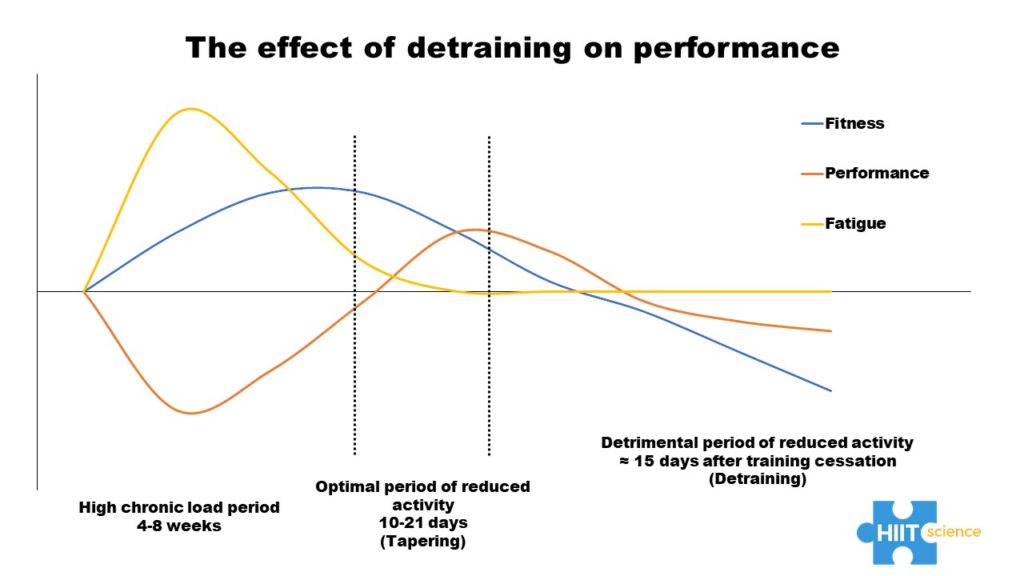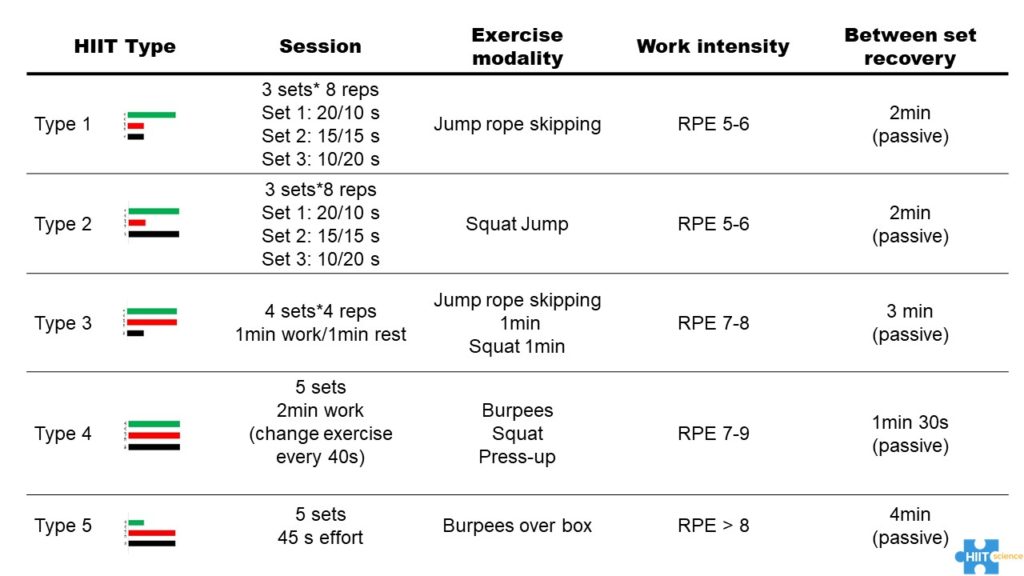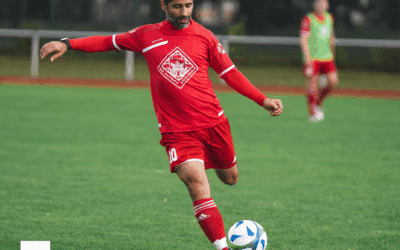Periods of reduced training, or training cessation, naturally lead to decreased fitness. The reduction in aerobic fitness that occurs will be inversely related to the aerobic training load accumulated before the period of reduced training. Using more technical jargon, the greater the chronic training load prior to training cessation, the lower the loss in fitness (1).
 Figure 1: Schematic representation of the detraining effect on performance.
Short sessions of high-intensity interval training (HIIT) appear to be the simplest and most time-efficient way to maintain fitness during those periods of reduced activity (3, 4). HIIT consists of repeated bouts of high-intensity exercise, involving a total of 10-15 min of effort. These exercise bouts are short (from 15 s to 3 min) and intense (perceived exertion of 8/10, targeting HR close to or above 90% of maximal HR), and separated by short (15 s to 2 min) relief periods (5).
Figure 1: Schematic representation of the detraining effect on performance.
Short sessions of high-intensity interval training (HIIT) appear to be the simplest and most time-efficient way to maintain fitness during those periods of reduced activity (3, 4). HIIT consists of repeated bouts of high-intensity exercise, involving a total of 10-15 min of effort. These exercise bouts are short (from 15 s to 3 min) and intense (perceived exertion of 8/10, targeting HR close to or above 90% of maximal HR), and separated by short (15 s to 2 min) relief periods (5).
 Table 1: Indoor HIIT sessions. Green bar: aerobic contribution; Red bar: anaerobic contribution; Black bar: neuromuscular contribution. The height of the bar represents the physiological emphasis of the session. Type 1: aerobic metabolic; Type 2: metabolic as type 1 but with a greater degree of neuromuscular strain; Type 3: metabolic as type 1 with a large anaerobic glycolytic energy contribution; Type 4: metabolic as type 3 but a high neuromuscular strain; Type 5: limited aerobic response but with a large anaerobic glycolytic energy contribution and high neuromuscular strain. More information about HIIT type here
In summary, when your training program meets unexpected circumstances that prevent completion as originally planned, remember that HIIT sessions, when properly prescribed and performed, can help to reduce the loss of fitness and performance potential even at home.
References
Table 1: Indoor HIIT sessions. Green bar: aerobic contribution; Red bar: anaerobic contribution; Black bar: neuromuscular contribution. The height of the bar represents the physiological emphasis of the session. Type 1: aerobic metabolic; Type 2: metabolic as type 1 but with a greater degree of neuromuscular strain; Type 3: metabolic as type 1 with a large anaerobic glycolytic energy contribution; Type 4: metabolic as type 3 but a high neuromuscular strain; Type 5: limited aerobic response but with a large anaerobic glycolytic energy contribution and high neuromuscular strain. More information about HIIT type here
In summary, when your training program meets unexpected circumstances that prevent completion as originally planned, remember that HIIT sessions, when properly prescribed and performed, can help to reduce the loss of fitness and performance potential even at home.
References
Interestingly, however, a reduction in training load over 2 weeks is often beneficial when it allows chronic fatigue to dissipate, and freshness to return (2). This phenomenon is used by all coaches and trainers to maximize the strategy known as tapering (1).Beyond 2 weeks of lowered activity, a decrease in aerobic-related performance is likely to occur (3, 4), which suggests that specific training should be programmed either: 1) during those initial weeks or 2) at least after those first two weeks to avoid substantial decrease in fitness and performance.
 Figure 1: Schematic representation of the detraining effect on performance.
Short sessions of high-intensity interval training (HIIT) appear to be the simplest and most time-efficient way to maintain fitness during those periods of reduced activity (3, 4). HIIT consists of repeated bouts of high-intensity exercise, involving a total of 10-15 min of effort. These exercise bouts are short (from 15 s to 3 min) and intense (perceived exertion of 8/10, targeting HR close to or above 90% of maximal HR), and separated by short (15 s to 2 min) relief periods (5).
Figure 1: Schematic representation of the detraining effect on performance.
Short sessions of high-intensity interval training (HIIT) appear to be the simplest and most time-efficient way to maintain fitness during those periods of reduced activity (3, 4). HIIT consists of repeated bouts of high-intensity exercise, involving a total of 10-15 min of effort. These exercise bouts are short (from 15 s to 3 min) and intense (perceived exertion of 8/10, targeting HR close to or above 90% of maximal HR), and separated by short (15 s to 2 min) relief periods (5).
Several studies have shown that only a few HIIT sessions are required to counteract the effect of periods of reduced training.One study in well-trained cyclists suggests that HIIT sessions can be programmed every 7-10 days over an 8-week transition period to maintain fitness and performance capacity (7). In semi-professional soccer players, the effective threshold frequency for repeating HIIT has been shown to be every 4 to 7 days over a 6-week off-season period (8), and up to 3 times per week across 2 weeks in another study (3). Traditionally, HIIT is performed by running or cycling in outdoor environments.
However, HIIT can easily be performed indoors, for instance on running treadmills, stationary bicycles or rowing ergometers (5).When such equipment is unavailable, HIIT can even be performed skipping using a jump rope or by completing stationary movements (e.g., squats, frontal or lateral lunges, push-ups, jumps) during the interval period (Table 1). These latter HIIT variations require more familiarisation and are likely more demanding on the neuromuscular system (6), but they can also be effective through their ability to target both cardiovascular and neuromuscular systems simultaneously (5).
 Table 1: Indoor HIIT sessions. Green bar: aerobic contribution; Red bar: anaerobic contribution; Black bar: neuromuscular contribution. The height of the bar represents the physiological emphasis of the session. Type 1: aerobic metabolic; Type 2: metabolic as type 1 but with a greater degree of neuromuscular strain; Type 3: metabolic as type 1 with a large anaerobic glycolytic energy contribution; Type 4: metabolic as type 3 but a high neuromuscular strain; Type 5: limited aerobic response but with a large anaerobic glycolytic energy contribution and high neuromuscular strain. More information about HIIT type here
In summary, when your training program meets unexpected circumstances that prevent completion as originally planned, remember that HIIT sessions, when properly prescribed and performed, can help to reduce the loss of fitness and performance potential even at home.
References
Table 1: Indoor HIIT sessions. Green bar: aerobic contribution; Red bar: anaerobic contribution; Black bar: neuromuscular contribution. The height of the bar represents the physiological emphasis of the session. Type 1: aerobic metabolic; Type 2: metabolic as type 1 but with a greater degree of neuromuscular strain; Type 3: metabolic as type 1 with a large anaerobic glycolytic energy contribution; Type 4: metabolic as type 3 but a high neuromuscular strain; Type 5: limited aerobic response but with a large anaerobic glycolytic energy contribution and high neuromuscular strain. More information about HIIT type here
In summary, when your training program meets unexpected circumstances that prevent completion as originally planned, remember that HIIT sessions, when properly prescribed and performed, can help to reduce the loss of fitness and performance potential even at home.
References
- Mujika I, Padilla S. Detraining: loss of training-induced physiological and performance adaptations. Part I: short term insufficient training stimulus. Sports Med. 2000;30(2):79-87.
- Buchheit M, Morgan W, Wallace J, Bode M, Poulos N. Physiological, psychometric, and performance effects of the Christmas break in Australian football. Int J Sports Physiol Perform. 2015;10(1):120-3.
- Joo CH. The effects of short term detraining and retraining on physical fitness in elite soccer players. PLoS One. 2018;13(5):e0196212.
- Christensen PM, Krustrup P, Gunnarsson TP, Kiilerich K, Nybo L, Bangsbo J. VO2 kinetics and performance in soccer players after intense training and inactivity. Med Sci Sports Exerc. 2011;43(9):1716-24.
- Laursen PB, Buchheit M. Science and Application of High-Intensity Interval Training (HIIT): Solutions to the Programming Puzzle: Human Kinetics; First edition (December 28, 2018); 2018. 664 p.
- Mate L, Lougedo JH, Barba M, & Garcı P. (2017). Muscular fatigue in response to different modalities of CrossFit sessions. PLoS ONE, 12(7), 1–17.
- Ronnestad BR, Askestad A, Hansen J. HIT maintains performance during the transition period and improves next season performance in well-trained cyclists. Eur J Appl Physiol. 2014;114(9):1831-9.
- Slettalokken G, Ronnestad BR. High-intensity interval training every second week maintains VO2max in soccer players during off-season. J Strength Cond Res. 2014;28(7):1946-51.






